Samsung Galaxy Note 10.1 (2014 Edition) Review
by Brian Klug & Anand Lal Shimpi on October 1, 2013 9:00 AM EST- Posted in
- Tablets
- Samsung
- Mobile
- Galaxy Note 10.1
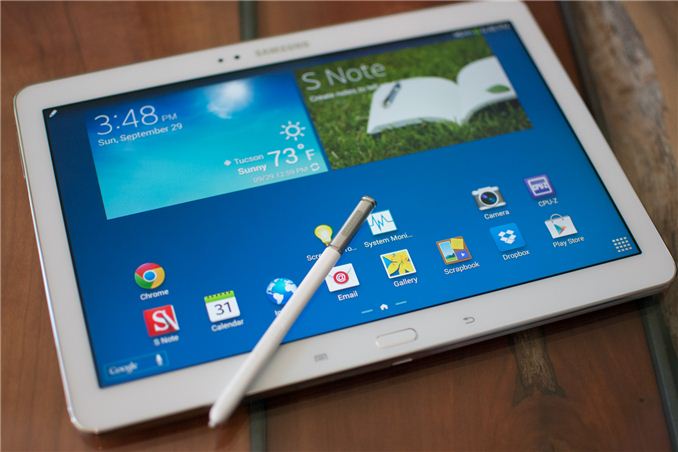
Ever since the arrival of the Nexus 10, it’s been hard recommending other, lower resolution 10-inch Android tablets. Although not the knock out success that the Nexus 7 became, the Nexus 10 did offer a good alternative to the iPad at a lower price. Given that Samsung made the aforementioned 10-inch Nexus, complete with 2560 x 1600 display, we wondered when a similar panel might grace Samsung’s own tablet lineup. A few weeks ago we got the answer we’ve been waiting almost a year for.
The latest iteration of Samsung’s Galaxy Note 10.1, aptly named the 2014 Edition, ships with the firm’s own 10.1-inch 2560 x 1600 display. It’s not display alone that Samsung hopes to sell its latest Note 10.1 on, the rest of the package is similarly specced to the max.
Unlike the Galaxy Note 3 where the majority of devices sold will likely use Qualcomm’s Snapdragon 800, the new Note 10.1 uses Samsung’s own Exynos 5420 SoC for all WiFi models. It’s only the LTE versions that will leverage Qualcomm silicon, but WiFi tablets still sell extremely well. All of this makes the 2014 Edition the first Samsung Android device to ship with its own Cortex A15 silicon in the US since the Nexus 10.
Add 3GB of RAM, tick the 802.11ac box and all you’re missing is USB 3.0 from the Galaxy Note 3. The result is Samsung’s first truly high end 10.1-inch Android tablet since the Nexus 10, and as its name implies, it comes with an S Pen. The entire bundle comes at a $150 premium to the much lower specced Galaxy Tab 3 10.1 and to the Galaxy Note 8.0:
| Specifications | |||||||||
| Samsung Galaxy Note 10.1 (2014 Edition) | Samsung Galaxy Tab 3 10.1 | Samsung Galaxy Note 8.0 | |||||||
| Dimensions | 243.1 x 171.4 x 7.9mm | 210.8 x 135.6 x 7.95mm | 210.8 x 135.6 x 7.95mm | ||||||
| Display | 10.1-inch 2560 x 1600 Super Clear LCD | 10.1-inch 1280 x 800 LCD | 8.0-inch 1280 x 800 LCD | ||||||
| Weight | 535g (WiFi) | 510g (WiFi) | 338g (WiFi) | ||||||
| Processor | 1.8GHz Samsung Exynos 5420 (4 x Cortex A15/4 x Cortex A7, Mali-T628MP6) |
1.6GHz Intel Atom Z2560 (2 x Atom , PowerVR SGX544MP2) |
1.6GHz Samsung Exynos 4412 (4 x Cortex A9, Mali 400MP4) |
||||||
| Connectivity | WiFi , Optional 3G/4G LTE | WiFi , Optional 3G/4G LTE | WiFi , Optional 3G/4G LTE | ||||||
| Memory | 3GB | 1GB | 2GB | ||||||
| Storage | 16GB—64GB + microSD | 16GB/32GB + microSD | 16GB/32GB + microSD | ||||||
| Battery | 31Wh | 25.84Wh | ~17Wh | ||||||
| Starting Price | $549 | $399 | $399 | ||||||
Design
Balancing a desire to make tons of sweet cash with criticisms about material quality, Samsung revamped its 2014 Note family with a new design. Rather than the smooth glossy plastic back we’ve seen with the previous generation of Notes, the Galaxy Note 10.1 2014 Edition inherits the same back cover finished in faux leather from the Galaxy Note 3.
I’ve already gone into detail on the improvement this is over the previous slick plastic in our Galaxy Note 3 review, but in short it’s a good step forward. There’s a difference in finish between the white and black versions (the latter has more of a grip laden rubbery texture), but both are better than the previous generation. We’re still talking about injection molded plastic and not real leather, but it’s a big step forward and honestly feels quite good in hand. The fake stitching is a bit much for me personally, though those looking for a more organic feel might appreciate it.
The new Note 10.1 maintains roughly the same dimensions as the new Galaxy Tab 3 10.1, although with far better internals and display.
The usual design staples are all here. There’s a microSD card slot on the right hand side as well as stowage for the new S Pen. Up top you’ll find the power/lock switch and volume rocker. There’s a physical home button front and center, flanked by capacitive menu and back buttons. The design is distinctly Samsung.
Software & OS
The 2014 Edition of the Galaxy Note ships with Android 4.3, as well as the typical set of S Pen, multi-window and other productivity enhancements you’d expect from a Samsung Note device. I’ve already gone through these in our Galaxy Note 3 review as well as in our Galaxy Note 8.0 review, so I’ll point you there for more details. In short, the S Pen is an interesting productivity addition to a tablet. It does a reasonable job of approximating a pen and paper experience, although understandably with more lag than you're used to (along with some other quirks).
CPU & Performance
The 5420 is Samsung’s second Exynos 5 Octa SoC, pairing a quad-core Cortex A15 cluster with a quad-core Cortex A7 cluster. The Note 10.1’s implementation still only supports cluster migration, with either the Cortex A15 or Cortex A7 cluster being active at once, effectively making the chip a quad-core SoC in the eyes of the user and OS. The point of having both A15 and A7 clusters on board is to be able to switch between the two depending on workload demands. If you need performance, a quad-core Cortex A15 is at your disposal, running at up to 1.8GHz (up from 1.6GHz in the previous Exynos 5410). If you need battery life however, the Cortex A7 cluster takes over running at up to 1.3GHz in the 5420 (up from 1.2GHz). Switching between the two is seamless as far as the OS is concerned, and for the first time the two clusters have a functioning cache coherent interconnect between the two (although it's not leveraged in the Note 10.1's implementation). Ideally Samsung’s implementation would go one step further and feature a cache shared between both clusters (rather than a 2MB L2 for the A15 cluster and 512KB L2 for the A7 cluster), but we’re still in the early days of big.LITTLE.
The 5420 performs understandably quite well. In lightly threaded tests the Note 10.1 pulls ahead of the old Nexus 10, but in those that exploit the tablet’s four A15 cores we see a significant jump forward. Samsung was able to deliver a relatively good experience with four Cortex A9 cores in their Galaxy Note 8, the new Note 10.1’s underlying hardware just does an even better job.
The four A15s are generally quicker then Qualcomm's Snapdragon 800/Krait 400s, but typically fall short of Intel's Atom Z3770 under Android as well as Apple's Cyclone cores in the A7.
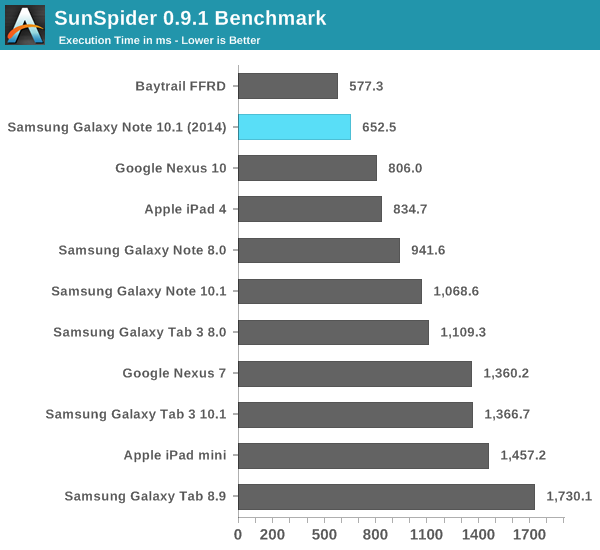
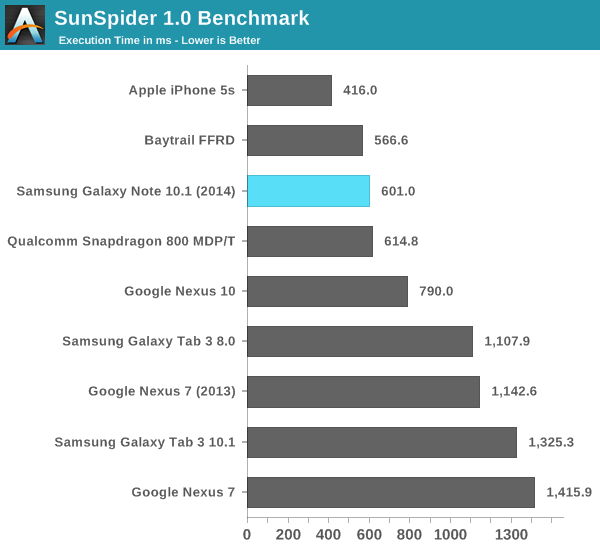
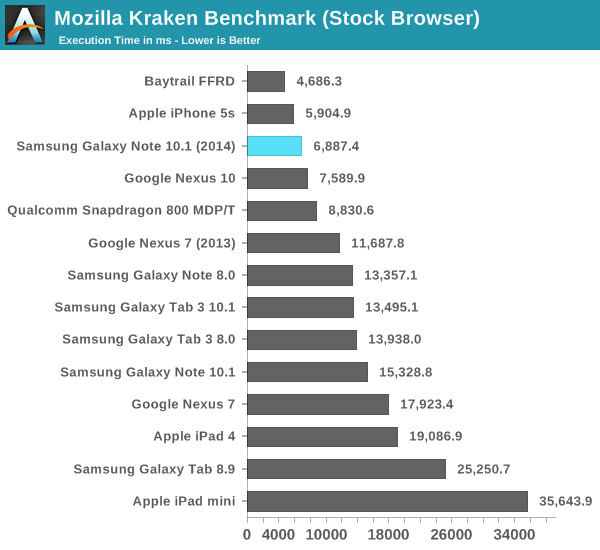
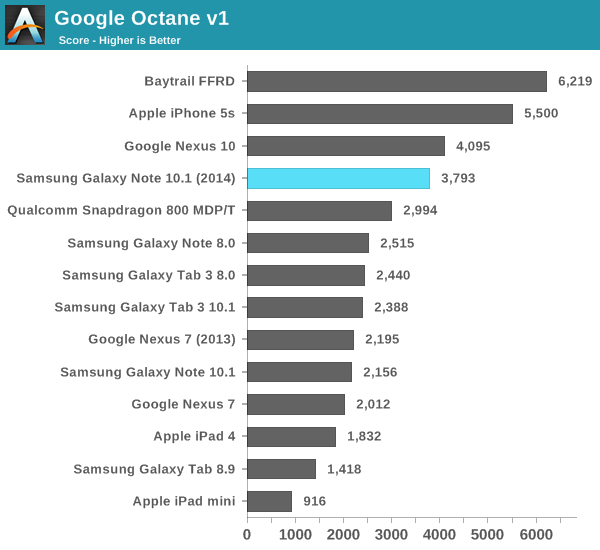
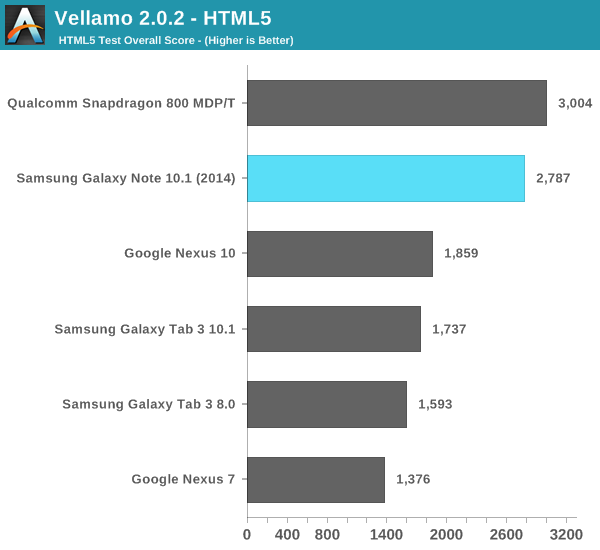



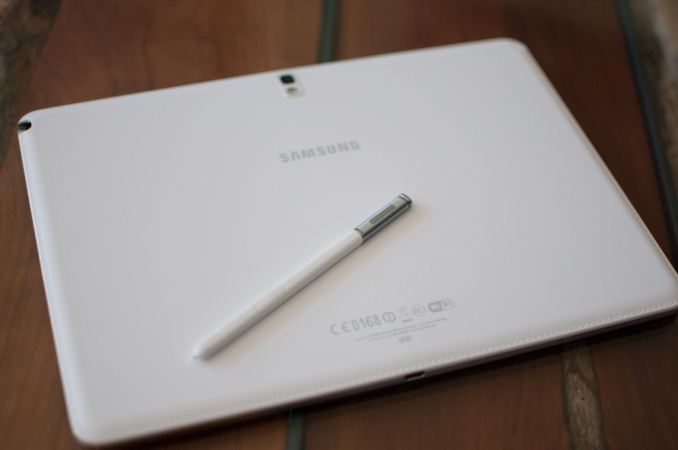
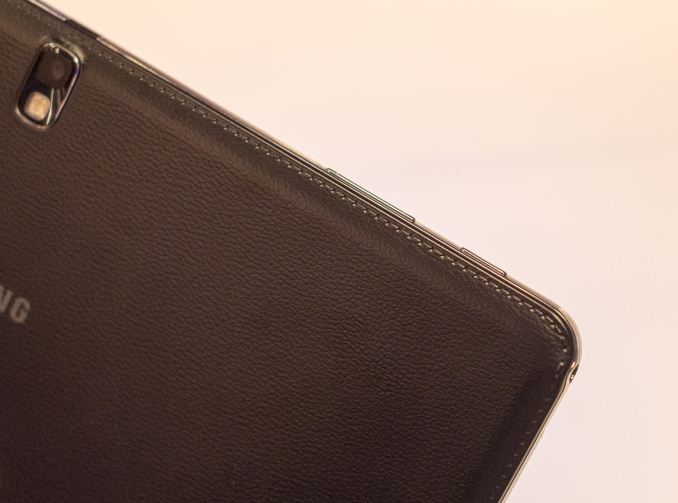








97 Comments
View All Comments
eiriklf - Tuesday, October 1, 2013 - link
Just to elaborate, the nexus 10 on chrome 30 beta pretty much matches the 5s in mozilla kraken and is not far behind in octane either, and I expect the nexus 10 will see regular performance improvements in the coming months.ESC2000 - Thursday, October 10, 2013 - link
You mean they both suck?KateMfield10 - Tuesday, October 1, 2013 - link
Another Android tablet with impressive features and price that launched this week is from tabletmaker Pipo Electronics and the new 9.7-inch Pipo M6 Pro($297) is getting much notice for its slim design and packs in a solid device that compares to the new Kindle Fire HDX and iPad for much less -- the Pipo M6 Pro offers 32GB and built-in GPS -- plus a 2048X1536 Liquid Crystal display, along with a Quad-Core processor - 1.6 GHz / 2GB Ram; it also features premium front speakers, Bluetooth 4.0, a truly large capacity 10,000 mAh battery, a MicroSD memory card slot, and high speed WiFi; and also offers quality dual cameras, Google Play preinstalled and an option to use standard Android 4.2.2 O/S or a user-friendly Windows style interface.One of the first sites in the U.S. with more details for this new model is-- TabletSprint
carlinafrelich - Tuesday, October 1, 2013 - link
til I looked at the check which was of $6274, I did not believe that...my... mother in law truly erning money part-time from their laptop.. there friend brother has been doing this for only about 18 months and recently cleard the debts on their home and got a new BMW 5-series. look at this website>>>>>> url.ℳn/23bb7d0XFire99 - Sunday, October 13, 2013 - link
U joking right? Since when is IP5S a tablet? It shouldnt be in this test at all and when the score is bad for IP5S. They didnt even incl it on the tests.Shootergod - Sunday, December 1, 2013 - link
Hi noob,surely they didn't list the geekbench 3 which they've used to mention before guess what? it has been helpless defeated there,beaten by Note 10.1 octa core version, and Note 10.1 2014 LTE ver. which runs Snapdragon 800 backed with 330 Adreno beats iphone 5s and ipad air hellishly in every single benchmark as usual. How about camera? ipad stucks with sucky 5mp camera which can't take any quality video and images while 8MP camera with flash can take so much better image s and vids with stereo sound recording. After apple introduce 64 bit chip,wow I see many apple fanboys popping out to bark at any tech lovers but before that they are the one saying nobody buys because of benchmark and nobody cares about it because of their shitty devices form ipad to ipad 4 and from iphone to iphone 5 lose to any Android devices,quite pathetic though,but what can I say since it is a world with freedom,everyone can choose whatever they want! Cheers!liahos1 - Tuesday, October 1, 2013 - link
Guys,Have you guys noticed stuttering / laggy performance of any sort. Verge and Engadget were pretty explicit on this. Just wondering if you've seen the same thing.
nerd1 - Tuesday, October 1, 2013 - link
I don't think they reviewed any android product which they claim to be 'laggy'Squuiid - Tuesday, October 1, 2013 - link
Does the note 10.1 2014 cheat benchmarks in the same way the Note 3 does?http://arstechnica.com/gadgets/2013/10/galaxy-note...
darwinosx - Tuesday, October 1, 2013 - link
Anand seems reluctant to come straight out and call it cheating. If any site should do that it would be this one.The horrible faux leather and stitching is bad enough on the Note 3 but just horrendous on a full size tablet.